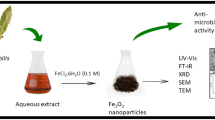Abstract
The structure and properties of Cu/Cu2O-containing nanocomposites formed by chemical reduction of Cu2+ ions in interpolyelectrolyte–metal complexes (IMC) at different molar ratios [NaBH4]: [Cu2+] and reduction times were studied by methods of wide- and small-angle X-ray scattering, transmission electron microscopy, thermomechanical analysis, and antimicrobial tests. Optimal conditions ([NaBH4]: [Cu2+] = 6.0, reduction time ≥ 120 min) for the formation of copper-containing nanocomposites based on interpolyelectrolyte complexes and Cu/Cu2O core–shell nanoparticles have been established by X-ray diffraction analysis. Owing to the above conditions, the structural manifestation of the metal copper phase is fully realized. Applying transmission electron microscopy, it was found that at molar ratio [NaBH4]: [Cu2+] = 6.0, and reduction time of 40 min and 180 min, accordingly, the nanocomposites with average nanoparticles size of 4.1 nm and 12.4 nm are derived from IMC, respectively, what correlates with effective size of the nanocomposites’ heterogeneity regions, lp. Thermomechanical analysis has shown that raise in the amount of reducing agent or the duration of reduction of Cu2+ ions in IMC is accompanied by elevation in the glass transition temperature, which reaches a constant level, boost in the temperature of transition to the viscous state Tf and decrease in the relative deformation of nanocomposites. The antimicrobial investigations of the elaborated nanocomposites revealed they possess an antimicrobial activity against S. aureus and E. coli strains.







Similar content being viewed by others
References
Badawy SM, El-Khashab RA, Nayl AA (2015) Synthesis, characterization and catalytic activity of Cu/Cu2O nanoparticles prepared in aqueous medium. Bull Chem React Eng Catal 10(2):169–174
Case CL, Johnson TR (1984) Laboratory experiments in microbiology. Benjamin Cummings Pub Inc., California, pp 126–129
Dang TMD, Le TTT, Fribourg-Blanc E, Dang MC (2011) The influence of solvents and surfactants on the preparation of copper nanoparticles by a chemical reduction method. Adv Nat Sci 2:025004
Demchenko V, Shtompel V, Riabov S (2016) Nanocomposites based on interpolyelectrolyte complex and Cu/Cu2O core–shell nanoparticles: structure, thermomechanical and electric properties. Eur Polym J 75:310–316
Demchenko V, Riabov S, Rybalchenko N, Goncharenko L, Kobylinskyi S, Shtompel V (2017) X-ray study of structural formation, thermomechanical and antimicrobial properties of copper-containing polymer nanocomposites obtained by the thermal reduction method. Eur Polym J 96:326–336
Garciduenas-Pina C, Medina-Ramirez IE, Guzman P, Rico-Martinez R, Morales-Dominguez JF, Rubio-Franchini I (2016) Evaluation of the antimicrobial activity of nanostructured materials of titanium dioxide doped with silver and/or copper and their effects on Arabidopsis thaliana. Int J Photoenergy 1:1–14
Gil M, Kim H, Bae J, Cha S-H, Lee KJ (2015) Preparation of metal-ion containing polymers: synthesis and characterization of methacryliccopolymers containing copper ion. Polymer 77:297–304
Guo Y, Cao F, Lei X, Mang L, Cheng S, Song J (2016) Fluorescent copper nanoparticles: recent advances in synthesis and applications for sensing metal ions. Nanoscale 8:4852–4863
Hema S, Thambiraj S, Shankaran DR (2018) Nanoformulations for targeted drug delivery to prostate cancer: an overview. J Nanosci Nanotechnol 18:5171–5191
Katti KV (2016) Renaissance of nuclear medicine through green nanotechnology: functionalized radioactive gold nanoparticles in cancer therapy–my journey from chemistry to saving human lives. J Radioanal Nucl Chem 309:5–14
Kruk T, Szczepanowicz K, Stefańska J, Socha RP, Warszyński P (2015) Synthesis and antimicrobial activity of monodisperse copper nanoparticles. Colloids Surf B 128:17–22
Lysenkov EA, Gagolkina ZO, Lobko EV, Yakovlev YuV, Nesin SD, Klepko VV (2015) Structure-property relationships in polymer nanocomposites based on cross-linked polyurethanes and carbon nanotubes. Funct Mater 22:342–349
Nicolais L (2005) Metal_polymer nanocomposites. Wiley, New York
Pazhooh HN, Bagheri R, Adloo A (2017) Fabrication of semi-conductive natural rubber nanocomposites with low copper nanoparticle contents. Polymer 108:135–145
Pergushov DV, Zezin AA, Zezin AB, Müller AHE (2014) Advanced functional structures based on interpolyelectrolyte complexes. Adv Polym Sci 255:173–226
Perret R, Ruland W (1971) Eine verbesserte Auswertungsmethode fur die Rontgenkleinewin-kelstreuung von Hochpolymeren. Kolloid Z.–Z. Polymere 247:835–843
Pomogailo AD, Kestelman VN (2005) Metallopolymer nanocomposites. Springer, New York
Porod G (1982) In: Glatter O, Kratky O (eds) Small-angle X-ray scattering. Acad Press, London
Ruland W (1971) Small-angle scattering of two-phase systems: Determination and significance of systematic deviations from Porod’s law. J Appl Cryst 4:70–73
Safiullah SM, Wasi KA, Basha KA (2015) Synthesis of poly(glycidyl methacrylate) copper nanocomposite beads by in-situ suspension polymerization and deposition method: a comparative study. Polymer 66:29–37
Wang Y, Asefa T (2010) Poly(allylamine)-stabilized colloidal copper nanoparticles: synthesis, morphology, and their surface-enhanced raman scattering properties. Langmuir 26:7469–7474
Wen J, Li J, Liu S, Chen Q (2011) Preparation of copper nanoparticles in a water/oleic acid mixed solvent via two-step reduction method. Colloid Surf A 373(1–3):29–35
Yamakoshi S, Sakai Y, Shinohara Y, Amemiya Y, Kanayama N, Takarada T, Maeda M, Ito K (2007) SAXS measurement of aggregate of DNA modified gold nanoparticles. Nucleic Acids Symp Ser 51:335–336
Zezin AA (2016) Synthesis of hybrid materials in polyelectrolyte matrixes: control over sizes and spatial organization of metallic nanostructures. Polym Sci C 58:118–130
Zezin AA (2019) Synthesis of metal-polymer complexes and functional nanostructures in films and coatings of interpolyelectrolyte complexes. Polym Sci A 61:754–764
Author information
Authors and Affiliations
Contributions
VD, VS, and SR designed and directed the research. LG, SK, and MI carried out experiments. VD, SK, and VS analyzed and interpreted the data. VD and SR wrote the manuscript.
Corresponding author
Ethics declarations
Conflict of interest
On behalf of all authors, the corresponding author states that there is no conflict of interest.
Additional information
Publisher's Note
Springer Nature remains neutral with regard to jurisdictional claims in published maps and institutional affiliations.
Rights and permissions
About this article
Cite this article
Demchenko, V.L., Shtompel, V.I., Riabov, S.V. et al. Preparation and characterization of Cu/Cu2O-containing nanocomposites based on interpolyelectrolyte complexes of pectin–polyethyleneimine. Appl Nanosci 10, 5479–5488 (2020). https://doi.org/10.1007/s13204-020-01395-x
Received:
Accepted:
Published:
Issue Date:
DOI: https://doi.org/10.1007/s13204-020-01395-x




